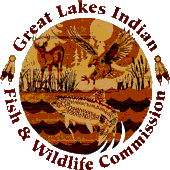Frequently asked questions (FAQs)
In order to obtain an off-reservation harvest permit, you must have a valid tribal picture ID from one of GLIFWC’s member tribes. The tribe’s on-reservation registration station conservation department can issue you an off-reservation harvest permit.
GLIFWC posts harvest information and the opening dates for date-regulated waters here.
Go to outreach programs and classes on the main page accordian for detailed information.
Treaty rights are rights retained in treaties negotiated between sovereigns. In the case of the Ojibwe in northern Michigan, Wisconsin and Minnesota, their headmen retained or kept the rights to hunt, fish and gather on lands they ceded to the U.S. government. These retained rights are called usufructuary rights, which means the right to use property. An example would be if a property owner sold land but retained mineral rights, or the right to access minerals beneath the surface. Another example would be retaining frailing rights in Oklahoma, where land is sometimes sold but the right to frail pecans on the land is retained by the first owner. Treaty rights are not some unique or “special” right that courts have granted certain tribes; rather they are legal usufructuary rights retained by tribes at the time the treaties were signed. Treaty rights are also tribal, not individual rights. They are held and regulated by the treaty signatory tribes.
No, only those who are members of tribes that were signatory to a treaty in which those rights were reserved.
All off-reservation treaty seasons are regulated through tribally-adopted codes. Harvest seasons and quotas are established and enforced. Quotas are frequently determined in meetings between state and tribal biologists who share their assessment data and through scientific models determine quotas for a variety of species. GLIFWC’s Enforcement staff patrol ceded territories during open seasons. Violators are cited into tribal courts.
GLIFWC develops reports on all treaty seasons, so information regarding harvests is available in Biological Reports on each season. These are found under the applicable section on this website. For instance, deer harvest reports will be under the Wildlife Section; walleye will be under the Inland Fisheries Section and lake trout will be under the Great Lakes Fisheries Section. Some harvest information is also available via graphs in the booklet A Guide to Understanding Ojibwe Treaty Rights.
Agreements between governments such as treaties are not invalidated by age, nor are other types of contracts made between individuals. The U.S. Constitution states that “treaties are the supreme law of the land,” consequently, they should be honored. Changes to the agreements can be negotiated if both parties consent. In terms of the Ojibwe treaty rights being practiced today, recent federal court decisions define the scope and regulation of treaty rights, making them compatible with modern day circumstances.
Nothing in the treaties states that the Ojibwe could not use modern methods or equipment to hunt, fish and gather, and federal courts have found that the Ojibwe may use modern methods of harvest when exercising their treaty rights. The bottom line is that effective management with harvest quotas protects the resource from overharvest no matter the method or the gear.
Some people believe that the treaty rights are unlimited in scope. This is not true. In Wisconsin, the Ojibwe, under a series of court rulings in the Voigt case, exercise off-reservation treaty rights limited by quotas, seasons and tribally-adopted regulations.
In Minnesota, tribal harvest is also subject to the specifications of adopted court stipulations which limit treaty quotas, set seasons, and place other restrictions on the treaty harvest. Management plans for the both the fishery and wildlife harvests are negotiated every five years. These plans provide the structure for a limited treaty harvest and safeguard the resources.

